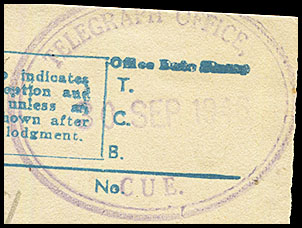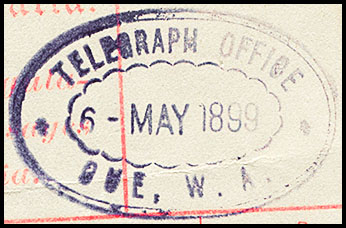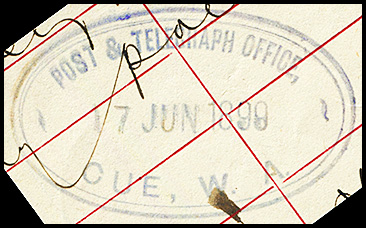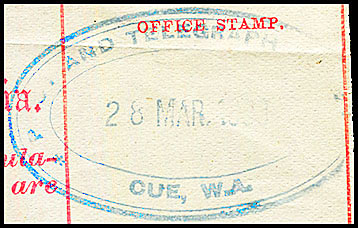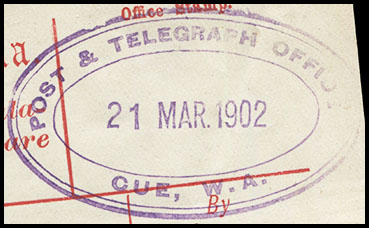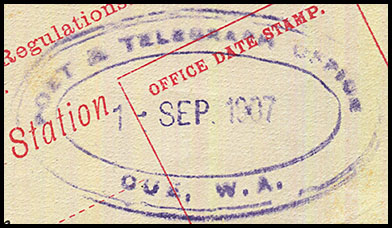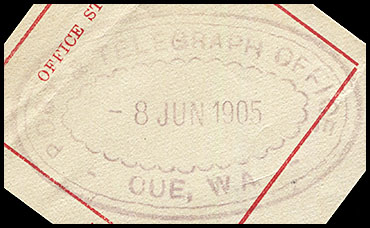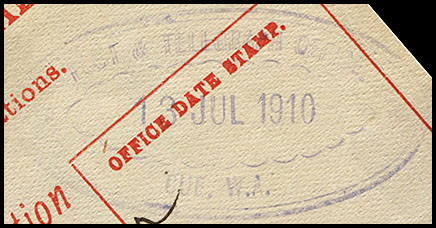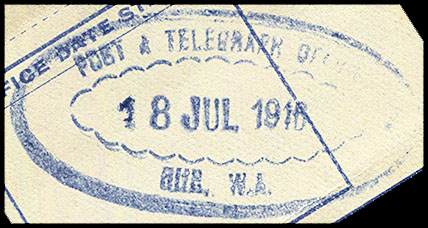Oval date stamps produced for Cue.
- Australia 1901-1988
- New South Wales
- Overview of NSW
- Telegraph lines
- Telegraph Offices
- Date stamps
- Forms
- Envelopes
- Instructional annotation
- Collect
- Delayed
- Free
- Immediate Urgent
- Reply paid
- Rates
- Stamps
- 1871 Telegraph stamps
- 1885 proposal
- 1893 proposal
- Queensland
- South Australia
- Tasmania
- Victoria
- Western Australia
- International
- Special aspects
Other listings of Cue oval date stamps list three formats. The formats were RO2, RO6 and RO7. The following analysis extends these previous classifications to eight distinct types. There were two different inscriptions at the top - either TELEGRAPH OFFICE or POST AND TELEGRAPH OFFICE (with variations). There were also the three different formats for the ovals.
Information which extends any of the statements is most welcome. An overview of date stamp classification and a description of eccentricity to measure their shape is provided elsewhere.
The Cue Telegraph Office opened in November 1894.
The date stamps are arranged below in order of inscription and then in order of complexity of design.
- Telegraph Office date stamps;
- Post and Telegraph Office date stamps.
Click on the following hyperlink for details of the Australian classification scheme for Telegraph date stamps.
| RO2 - TO.
Two formats depending on the eccentricity of the oval - the lower the value, the more circular. |
|
No W.A. after Cue but it is followed with a stop.
|
|
|
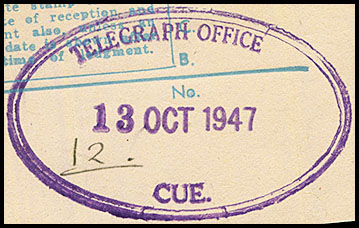 13 October 1947. In violet. |
| RO6 - TO.
Has stars for separation between upper and lower inscriptions.
Many of these date stamps are very light and the 9 is missing im many. |
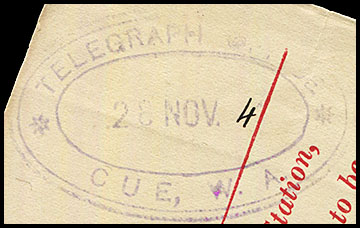 Telegraph Office. 28 November 1894. Used on WC-DO-4Ca. |
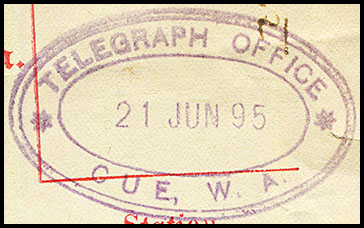 21 June 1895. Telegraph Offive in violet. On piece. |
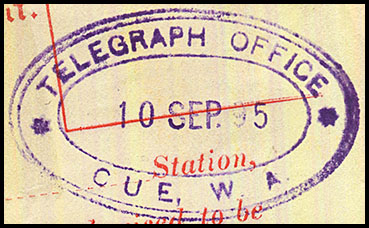 10 September 1895. Telegraph Office in violet. Used on WC-DO-4Ca. |
| RO7 - TO.
Has separations rosettes between upper and lower inscriptions.
See rare use of both this format and format RO2-P&TO on the same delivery form. |
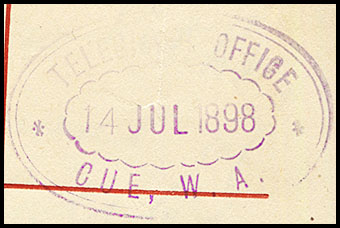 14 July 1898. Telegraph Offoce in violet. Used on WC-DO-4C. |
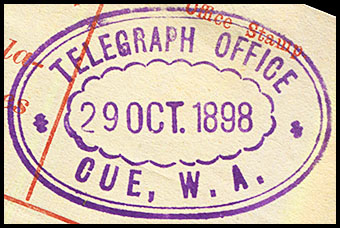 29 October 1898. Telegraph Office in violet. On piece. |
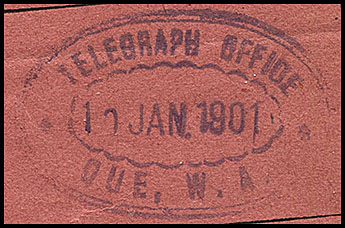 Telegraph Office in violet. 10 January 1901. |
| Some examples - especially the later ones, the C of CUE has no gap. | |
|
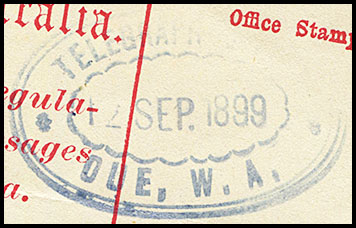 12 September 1899. Telegraph Office in blue. Used on WC-DO-5A. |
|
|
| RO2 - P & TO.
Post & Telegraph Office.
See rare use of this format and format RO7-TO on the same delivery form. |
|
|
| Although few examples of this format are recorded, all have an overinked C or the letter had not been cut correctly. | 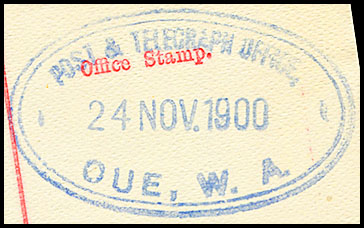 24 November 1900. In blue. |
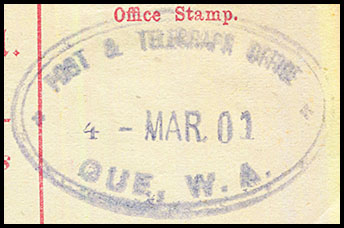 4 March 1901. in violet. |
| RO7 - P & TO. Post & Telegraph Office in top border confined above horizontal diameter. |
||
Type 1: Words in the top half of the outer ring are separated from words in the lower half by lozenges.
|
|
|
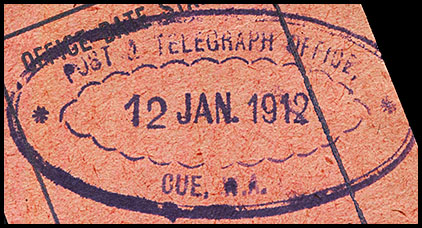 12 January 1912. Oval used in blue on an urgent rate telegram. Note the small split in the LH of the inner scalloped ellipse. |
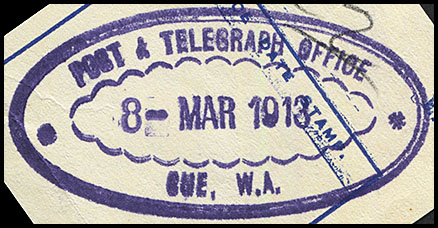 8 March 1913. Note the deterioration of the small split in the LH of the inner scalloped ellipse. |
|
|
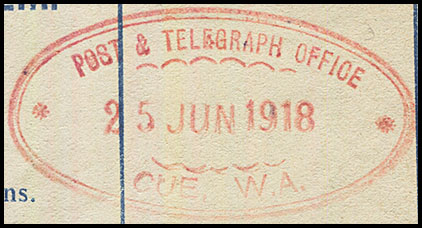 25 June 1918. |
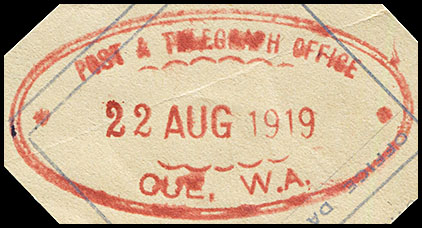 22 August 1919. Overinking on C of Cue. |
| RO7 - P & TO. Post & Telegraph Office in top border confined above horizontal diameter but the lozenges for separation are moved a shortway into the lower half of the outer ring. |
||
|
||
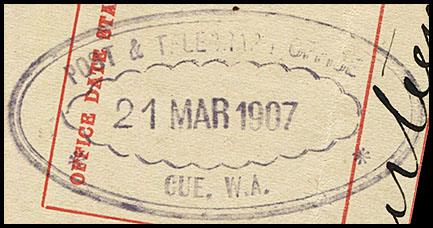 21 March 1907. |
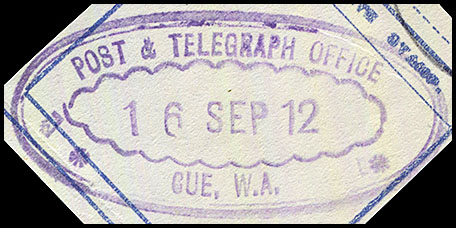 16 September 1912 - in violet. |
|
No separation markings in outer ring.
|
|
Has small vertical dash separation marks at either end of the outer ring.
|
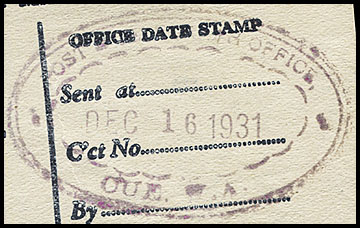 16 December 1931. Used on Commonwealth delivery form AB-DO-6A. |
